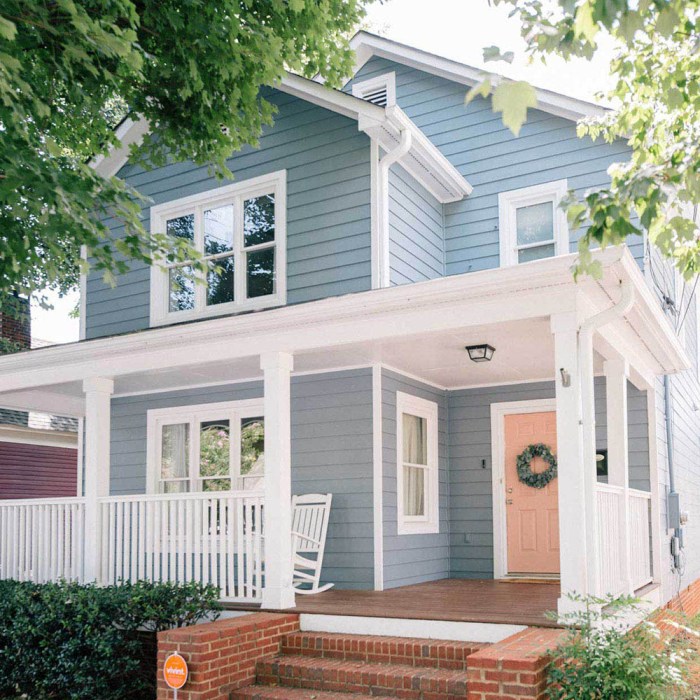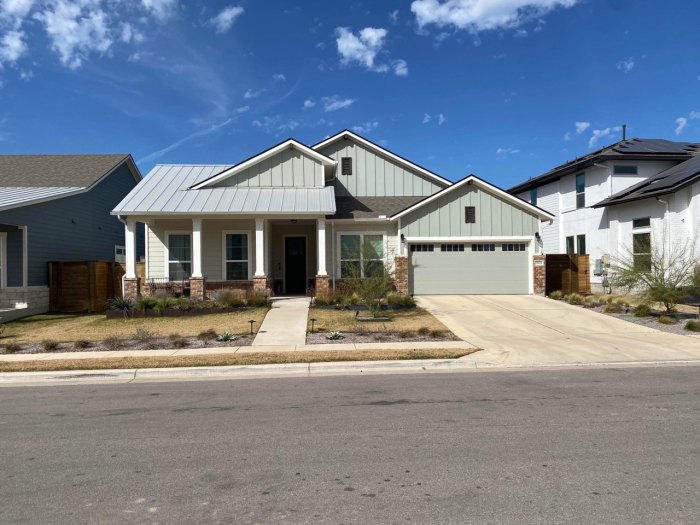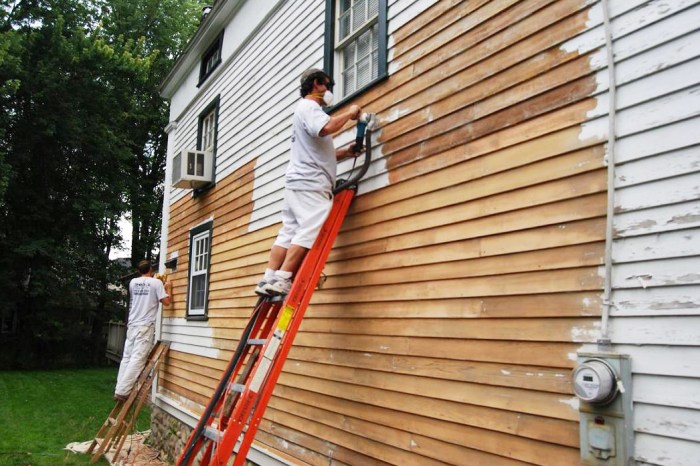Exterior Home Painting in Austin, TX: A Guide to Enhance Your Curb Appeal
Exterior Home Painting in Austin, TX sets the stage for this enthralling narrative, offering readers a glimpse into a story that is rich in detail and brimming with originality from the outset. Austin, known for its vibrant culture and stunning architecture, presents unique challenges for homeowners looking to refresh their exterior.
The scorching Texas sun, humid climate, and prevalence of cedar wood demand careful consideration when choosing paint and planning the painting process. This guide will equip you with the knowledge and insights needed to transform your home’s exterior, enhancing its aesthetic appeal, protecting it from the elements, and boosting its value.
From understanding the nuances of different paint types to mastering the art of preparation, this comprehensive guide will delve into every aspect of exterior home painting in Austin. We’ll explore the best practices for choosing the right paint, preparing your home for the job, and navigating the painting process itself.
We’ll also provide valuable tips for finding reputable painting contractors and maintaining your freshly painted exterior, ensuring your investment lasts for years to come.
Exterior Home Painting in Austin, TX

Austin, TX, is a vibrant city known for its beautiful homes and warm climate. However, the city’s unique weather conditions and the prevalence of cedar wood can pose challenges for maintaining a home’s exterior. A fresh coat of paint is essential for preserving your home’s beauty and protecting it from the elements.
This article will discuss the importance of exterior home painting in Austin, the benefits it offers, and the specific challenges posed by the city’s climate.
Benefits of Exterior Home Painting in Austin
Exterior home painting in Austin provides numerous benefits that enhance both the aesthetic appeal and longevity of your home. These benefits include:
- Enhanced Curb Appeal:A fresh coat of paint instantly revitalizes your home’s exterior, giving it a more appealing and modern look. This can increase your home’s value and make it more attractive to potential buyers.
- Protection from the Elements:Paint acts as a protective barrier against the harsh Texas sun, rain, and humidity. It prevents moisture damage, fading, and deterioration of the underlying wood or siding, extending the lifespan of your home’s exterior.
- Increased Property Value:A well-maintained exterior, including a fresh coat of paint, can significantly increase your home’s value. Potential buyers are more likely to be attracted to a home that appears well-cared for and visually appealing.
Challenges of Painting Homes in Austin’s Climate
Austin’s climate presents unique challenges for exterior home painting. The city experiences high temperatures, humidity, and the presence of cedar wood, which can affect paint adhesion and durability. These challenges require specific considerations and techniques to ensure a successful paint job.
- High Temperatures:The scorching summer heat in Austin can cause paint to dry too quickly, leading to uneven application and cracking. It is crucial to choose paint formulations specifically designed for high temperatures and to apply the paint in the early morning or late evening when temperatures are cooler.
- Humidity:Austin’s humid climate can create challenges for paint adhesion and drying time. The presence of moisture can cause paint to bubble, peel, or mildew. It is essential to use paints formulated for humid climates and to allow adequate drying time between coats.
- Cedar Wood:Cedar wood is commonly used in Austin homes, but it can be challenging to paint due to its porous nature and tendency to bleed through paint. Proper preparation, including sanding and priming, is essential to achieve a smooth and durable finish on cedar wood.
Choosing the Right Paint for Your Austin Home

Selecting the right paint for your Austin home is crucial for ensuring its longevity and aesthetic appeal. Austin’s unique climate, characterized by hot summers, mild winters, and occasional rain, demands paint that can withstand the elements and maintain its vibrancy.
Types of Exterior Paint
The three main types of exterior paint are acrylic, latex, and oil-based. Each offers unique properties, making it essential to understand their strengths and weaknesses to make an informed decision.
- Acrylic Paint: Acrylic paint is a popular choice for exterior painting due to its versatility, durability, and ease of application. It offers excellent adhesion to various surfaces, including wood, stucco, and brick. Acrylic paint is water-based, making it easy to clean up with soap and water.
Additionally, it dries quickly, allowing for multiple coats in a single day. However, acrylic paint can be susceptible to cracking in extreme temperature fluctuations, which can be a concern in Austin’s hot summers and mild winters.
- Latex Paint: Latex paint is another water-based option that offers good adhesion, durability, and resistance to mildew. It dries quickly and cleans up easily, making it a popular choice for DIY projects. However, latex paint may not be as durable as acrylic paint in extreme weather conditions, particularly in direct sunlight.
- Oil-Based Paint: Oil-based paint is known for its durability, moisture resistance, and excellent color retention. It forms a tough, protective barrier against the elements, making it ideal for high-traffic areas and surfaces exposed to harsh weather conditions. However, oil-based paint takes longer to dry and requires mineral spirits for cleanup, making it less convenient for DIY projects.
It also emits strong fumes during application, which can be a concern for sensitive individuals.
Paint Recommendations for Different Surfaces
The type of paint you choose should also be tailored to the specific surface you’re painting.
- Siding: For siding, acrylic paint is a popular choice due to its excellent adhesion and durability. Latex paint is also a viable option, especially for vinyl siding. Oil-based paint is generally not recommended for siding as it can trap moisture and lead to rot.
- Trim: Trim often requires a paint that can withstand high traffic and resist scratches. Acrylic paint is a good choice for trim, as it offers good durability and is available in a wide range of colors. Oil-based paint can also be a good option for trim, as it provides a tough, protective barrier.
However, oil-based paint can be more difficult to work with and may not be the best choice for all trim applications.
- Doors: Doors are exposed to frequent use and weathering, making it important to choose a durable paint. Acrylic paint is a good option for doors, as it offers good adhesion, durability, and color retention. Oil-based paint is also a viable option for doors, as it provides a tough, protective barrier.
However, oil-based paint can be more difficult to work with and may not be the best choice for all door applications.
Preparing Your Home for Exterior Painting

A well-prepared home is the foundation for a beautiful and long-lasting paint job. Taking the time to thoroughly prepare your home’s exterior will ensure that the paint adheres properly and lasts for years to come.
Cleaning and Power Washing
Cleaning and power washing your home’s exterior removes dirt, grime, mildew, and loose paint, creating a clean surface for the new paint to adhere to.
- Remove loose paint and debris: Use a scraper or wire brush to remove any loose paint or debris from the surface.
- Clean the siding with soap and water: Use a mild detergent and a soft-bristled brush to scrub the siding. Avoid using harsh chemicals that can damage the siding.
- Power wash the exterior: A power washer will effectively remove stubborn dirt, grime, and mildew. Be careful not to use too much pressure, as this can damage the siding.
Repairing Damaged Areas
Repairing any damaged areas before painting will prevent the paint from cracking or peeling in the future.
- Caulk cracks and gaps: Use a high-quality caulk to fill in any cracks or gaps in the siding, trim, or windows.
- Patch holes and dents: Use a patching compound to fill in any holes or dents in the siding.
- Replace damaged siding: If the siding is severely damaged, it’s best to replace it before painting.
Protecting Landscaping and Surrounding Areas
Protecting your landscaping and surrounding areas during the preparation process will prevent damage and ensure a clean and safe work environment.
- Cover plants and shrubs: Use tarps or plastic sheeting to cover any plants or shrubs near the work area.
- Protect walkways and driveways: Cover walkways and driveways with drop cloths or plastic sheeting to prevent paint spills and splatters.
- Remove outdoor furniture and other objects: Move any outdoor furniture, toys, or other objects away from the work area.
Safety Precautions
Using proper safety equipment and taking precautions during the preparation phase will help ensure a safe and successful project.
- Wear protective gear: Always wear safety glasses, gloves, and a respirator when working with paint, chemicals, or power tools.
- Use ladders safely: Ensure ladders are stable and positioned on a level surface before climbing.
- Be aware of electrical hazards: Take care to avoid electrical wires and outlets when working on the exterior of the home.
The Exterior Painting Process
Painting the exterior of your Austin home is a significant investment that can enhance its curb appeal and protect it from the elements. Understanding the exterior painting process will help you make informed decisions and ensure a successful project.
Stages of the Exterior Painting Process
The exterior painting process involves several distinct stages, each crucial for achieving a long-lasting and aesthetically pleasing finish.
- Preparation: This stage is the foundation of a successful paint job. It involves cleaning the exterior surfaces, repairing any damage, and applying primer.
- Priming: Applying a primer before painting is essential for creating a smooth, even surface that allows the paint to adhere properly. Primer also helps to seal the surface and prevent stains from bleeding through.
- Painting: The actual painting process involves applying coats of paint to the prepared surfaces. Multiple coats are usually necessary for optimal coverage and durability.
- Finishing Touches: Once the paint has dried, any final touches, such as painting trim, doors, or windows, can be completed. This stage also includes cleaning up any spills or splatters.
Applying Paint Effectively and Efficiently
Proper application techniques are crucial for achieving a smooth, even finish and maximizing the paint’s longevity.
- Using the Right Tools: High-quality brushes, rollers, and spray equipment are essential for applying paint effectively. Brushes are ideal for intricate details, while rollers provide faster coverage for large areas. Spray equipment can be used for even larger surfaces but requires more preparation and expertise.
- Thinning Paint: Thinning paint according to the manufacturer’s instructions can improve its flow and application. However, over-thinning can compromise the paint’s durability.
- Using Proper Strokes: The direction and length of your brushstrokes can significantly impact the final finish. For example, long, even strokes are ideal for achieving a smooth, consistent finish.
- Applying Multiple Coats: Applying multiple thin coats of paint is generally better than applying one thick coat. This allows the paint to dry evenly and creates a more durable finish.
Importance of High-Quality Painting Tools
Investing in high-quality brushes, rollers, and spray equipment is essential for achieving optimal results.
- Brushes: High-quality brushes have bristles that are designed for specific types of paint and surfaces. They provide better control and application, resulting in a smoother finish.
- Rollers: Rollers with high-quality nap are essential for achieving even coverage and preventing streaks. The nap length should be chosen based on the surface texture.
- Spray Equipment: For large areas, spray equipment can be a time-saving option. However, it requires more preparation and expertise to achieve a professional finish.
Finding the Right Painting Contractor in Austin
Painting your home’s exterior is a significant investment, and choosing the right contractor can make all the difference in the final outcome and your overall satisfaction. Selecting a reliable and experienced contractor is crucial to ensure quality workmanship, a smooth project, and a beautiful finish.
Evaluating Contractor Experience and Reputation
Choosing a contractor with experience in exterior painting is essential for a successful project. Experienced contractors understand the unique challenges of Austin’s climate and can recommend the best paints and techniques for your specific needs. To assess their experience, ask for a portfolio of previous projects and references from past clients.
You can also check online reviews and ratings on websites like Angie’s List, Yelp, and HomeAdvisor to gauge the contractor’s reputation.
Getting Quotes and Comparing Services
When getting quotes from multiple contractors, it’s important to ensure you’re comparing apples to apples. Ask each contractor to provide a detailed breakdown of the scope of work, including the type of paint, preparation methods, and cleanup procedures. Be sure to ask about the following:
- Paint quality and brands: Inquire about the specific types and brands of paint they use and their warranty information.
- Preparation methods: Ask about their process for preparing the surface, including power washing, scraping, and patching any damaged areas.
- Painting techniques: Find out if they use spray painting, brush painting, or a combination of methods.
- Cleanup and disposal: Ensure they have a plan for cleaning up the work area and disposing of paint waste responsibly.
- Project timeline: Discuss the estimated timeframe for completing the project and any potential delays.
- Payment terms: Ask about their payment schedule and whether they require a deposit.
Verifying Insurance and Bonding
Before hiring a contractor, it’s crucial to verify their insurance and bonding information. This protects you in case of accidents or damage to your property during the project. Request copies of their general liability insurance and workers’ compensation insurance certificates.
Bonding ensures that the contractor can complete the project as agreed upon and provides financial protection if they fail to do so.
It’s essential to confirm that the contractor’s insurance coverage is current and sufficient to cover potential risks.
Maintaining Your Freshly Painted Exterior: Exterior Home Painting In Austin, TX
Investing in a fresh coat of paint for your Austin home is a great way to enhance its curb appeal and protect it from the elements. However, to ensure your investment lasts and your home continues to look its best, proper maintenance is crucial.
This involves regular cleaning, touch-ups, and protecting the paint from damage.
Regular Cleaning
Regular cleaning is essential to keep your exterior paint looking its best and remove any dirt, grime, or mildew that can accumulate over time. Here are some tips for cleaning your home’s exterior:
- Use a mild detergent and soft-bristled brush:Harsh chemicals or abrasive cleaners can damage your paint, so it’s best to stick with a mild detergent and soft-bristled brush.
- Rinse thoroughly:After cleaning, rinse your home’s exterior thoroughly with clean water to remove any soap residue.
- Consider pressure washing:Pressure washing can be a more effective way to remove dirt and grime, but it’s important to use the right pressure setting and technique to avoid damaging your paint.
- Clean gutters and downspouts:Clogged gutters and downspouts can lead to water damage and paint deterioration, so it’s important to clean them regularly.
Touch-Ups
Even with regular cleaning, your exterior paint will eventually show signs of wear and tear. Touch-ups are essential to prevent minor damage from becoming more significant.
- Inspect regularly:Regularly inspect your home’s exterior for any signs of peeling, chipping, or fading paint.
- Use the same paint:When touching up paint, use the same type and color of paint as the original to ensure a seamless finish.
- Apply thin coats:Apply thin coats of paint to avoid drips and runs.
- Allow paint to dry completely:Allow each coat of paint to dry completely before applying the next.
Protecting the Paint, Exterior Home Painting in Austin, TX
Protecting your exterior paint from damage can help extend its lifespan and keep your home looking its best. Here are some tips:
- Trim trees and shrubs:Overhanging branches and shrubs can scratch your paint and create moisture buildup, leading to mold and mildew growth.
- Clean up spills and debris:Spills and debris can damage your paint, so it’s important to clean them up promptly.
- Use protective coverings:If you’re using power tools or other equipment near your home, use protective coverings to prevent damage to your paint.
- Avoid using harsh chemicals:Harsh chemicals, such as fertilizers and pesticides, can damage your paint.
Closing Summary
Painting your home’s exterior in Austin, TX is more than just a cosmetic upgrade. It’s an investment in your home’s longevity, beauty, and value. By following the steps Artikeld in this guide, you can confidently tackle this project, achieving a stunning transformation that will leave a lasting impression.
Remember, proper preparation, careful paint selection, and skilled execution are the keys to a successful exterior painting project that will elevate your home’s curb appeal and provide years of enjoyment.
Clarifying Questions
What is the best time of year to paint the exterior of my home in Austin?
The ideal time to paint your home’s exterior in Austin is during the spring or fall when temperatures are moderate, and humidity levels are lower. Avoid painting during extreme heat or cold, as this can affect the paint’s drying time and adhesion.
How long does it typically take to paint the exterior of a home in Austin?
The time it takes to paint the exterior of a home in Austin varies depending on the size of the house, the complexity of the project, and the number of painters involved. A typical two-story home can take anywhere from a few days to a week or more.
How much does it cost to paint the exterior of a home in Austin?
The cost of painting the exterior of a home in Austin can vary widely depending on the size of the house, the type of paint used, the complexity of the project, and the contractor’s rates. It’s essential to get quotes from multiple reputable contractors to compare prices and services.